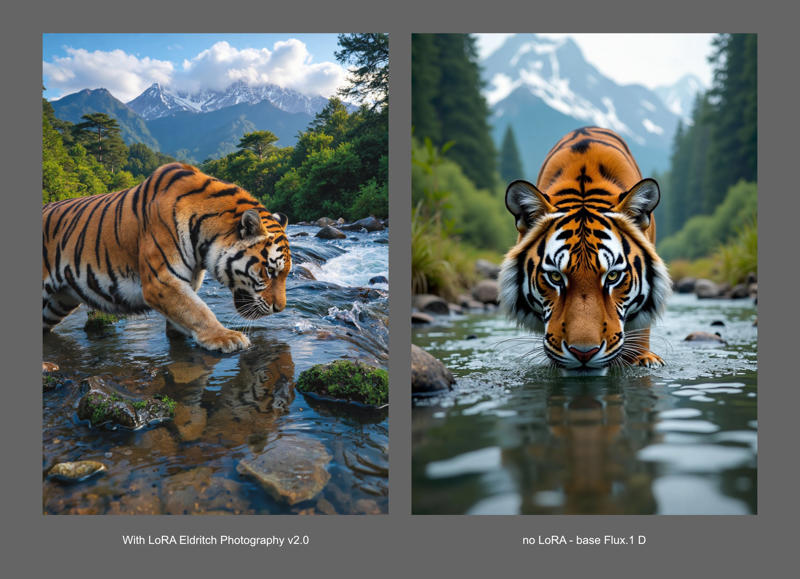Verified: 10 months ago
SafeTensor
The FLUX.1 [dev] Model is licensed by Black Forest Labs. Inc. under the FLUX.1 [dev] Non-Commercial License. Copyright Black Forest Labs. Inc.
IN NO EVENT SHALL BLACK FOREST LABS, INC. BE LIABLE FOR ANY CLAIM, DAMAGES OR OTHER LIABILITY, WHETHER IN AN ACTION OF CONTRACT, TORT OR OTHERWISE, ARISING FROM, OUT OF OR IN CONNECTION WITH USE OF THIS MODEL.
Dramatic light, realistic textures, romantic color, and long depth-of-field photos
Version 2.0 - simpler prompting and greater consistency Above is the same prompt/settings for a tiger, with and without the LoRA. For more comparisons, please check this long image at Imgur.
Above is the same prompt/settings for a tiger, with and without the LoRA. For more comparisons, please check this long image at Imgur.
plenty of models figured out how to get Flux to render backgrounds, but almost always by training on analog, or snapshot-style photography. This model wants to give you the backgrounds while still focusing on maximal drama and cinematic style.
I set out to improve on the model's interiors. But what I got from this attempt was an all-around-improved model. Most notably, you can get consistent results in the target aesthetic with minimal prompting. Previously, you needed to write elaborate descriptions of backgrounds to have them in detail. But the model had an aha! moment and now understands its real purpose: always give us a detailed background.
Prompt for photographic scenes, don't worry overly much about how detailed you are, and enjoy the results.
As always, I'll gladly hear feedback for how it may still be improved.
notes for previous versions:
in Forge, please enable 'FP16 LoRA mode'
Use the word 'Photography' in your prompt: This model is prone to generate illustrations - really nice ones! - if you don't emphasize 'photography' enough. Be sure to prompt clearly for photographs! For fantasy and sci-fi scenes I begin and end prompts with photo terms.
If you want long depth of field/in-focus background: describe your background. Just write up some unique characteristics about what's back there - you'll get more focus on it.
Unlike with most other approaches taken with Flux, this won't mean you need to abandon cinematic/professional photo styles. Things can look both epic and have long depth of field. You can push this model toward snapshot or analog style images, though it's better done with a specific LoRA aimed at such.
If you want a blurred background: describe a foreground subject and refer to the background as sparsely and generically as possible. It will give you a focus on the subject and blur the background most of the time. Or reduce the strength of or don't use this LoRA, LOL. It's got positive impact outside of DOF so for photo prompts, I'm using it by default.
I started by training Flux on the same dataset as used for the SDXL model, Eldritch Candid Photography - that didn't yield pleasing results at all. So I changed the dataset a bunch, reduced the noise texture a ton, and modified the color/tonal edits. This produced a very nice Beta model.
But I didn't think the imposed tone and grain were doing as much service to this model as to the inspiration XL model. So, I trained a new model on the same dataset (very long DOF images) without any processing to them. On its own, images output from it were kind of harsh and austere looking. So I merged that with the beta model and got a really nice v1.0
But this still wasn't quite what I was looking for. So I tried a few other approaches and merge techniques before deciding on a simple curves adjustment to my dataset to heighten contrast and achieve a consistent dramatic lighting across them all. This one all on its own was close to the final target! But I tested a bunch of simple merges with my various models and settled on what is v 1.2 - I expect to be the final state of this thing for Flux.1 D

